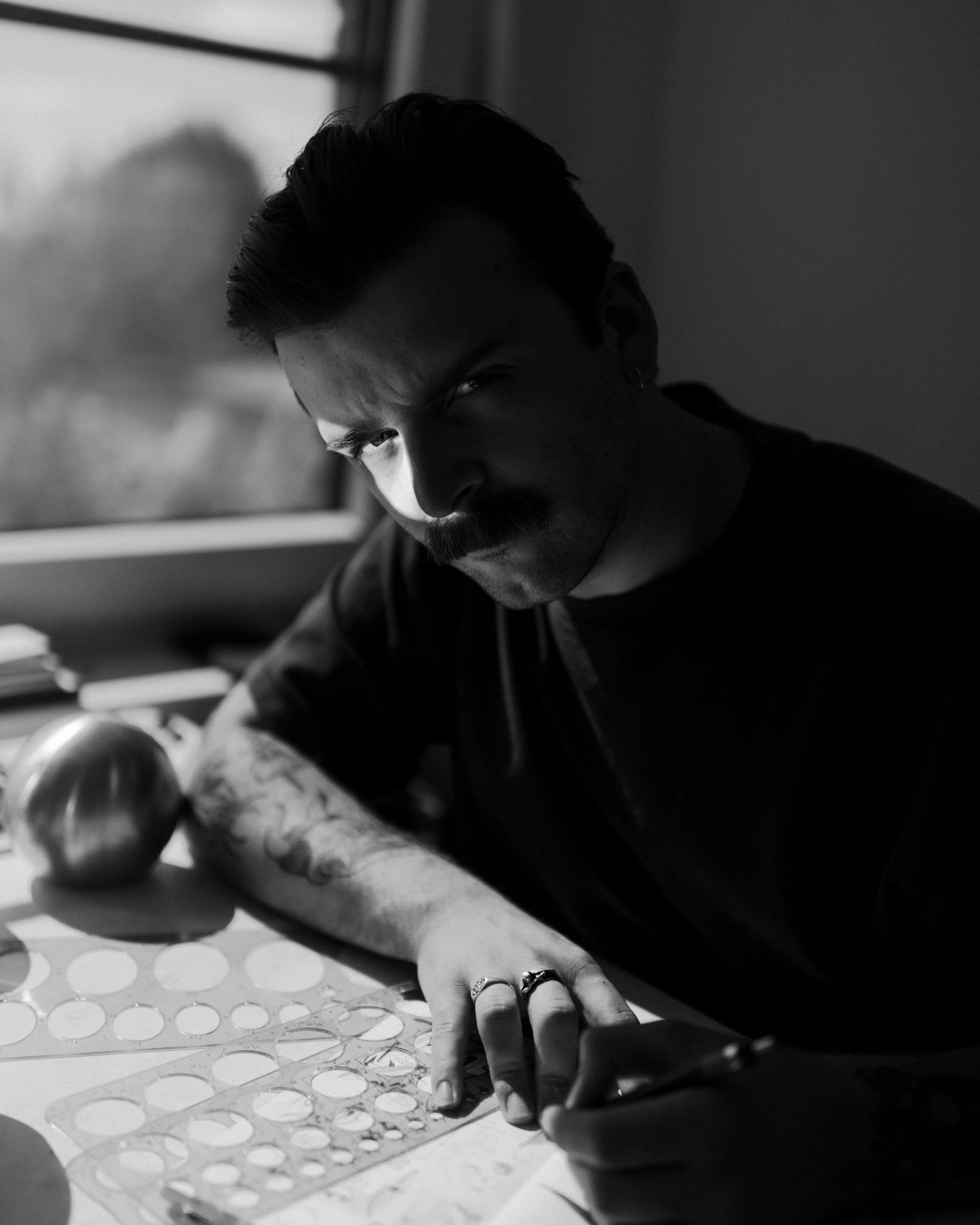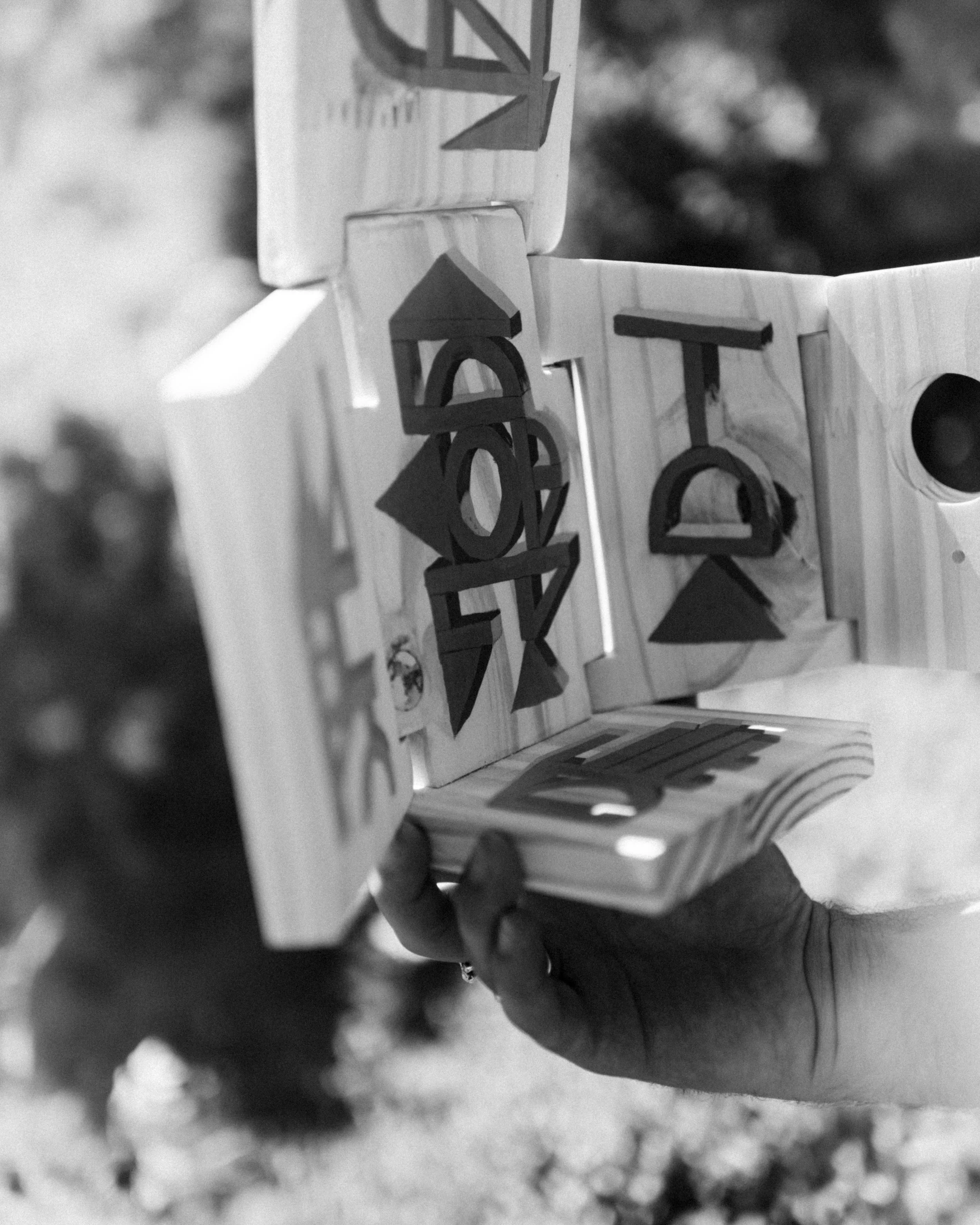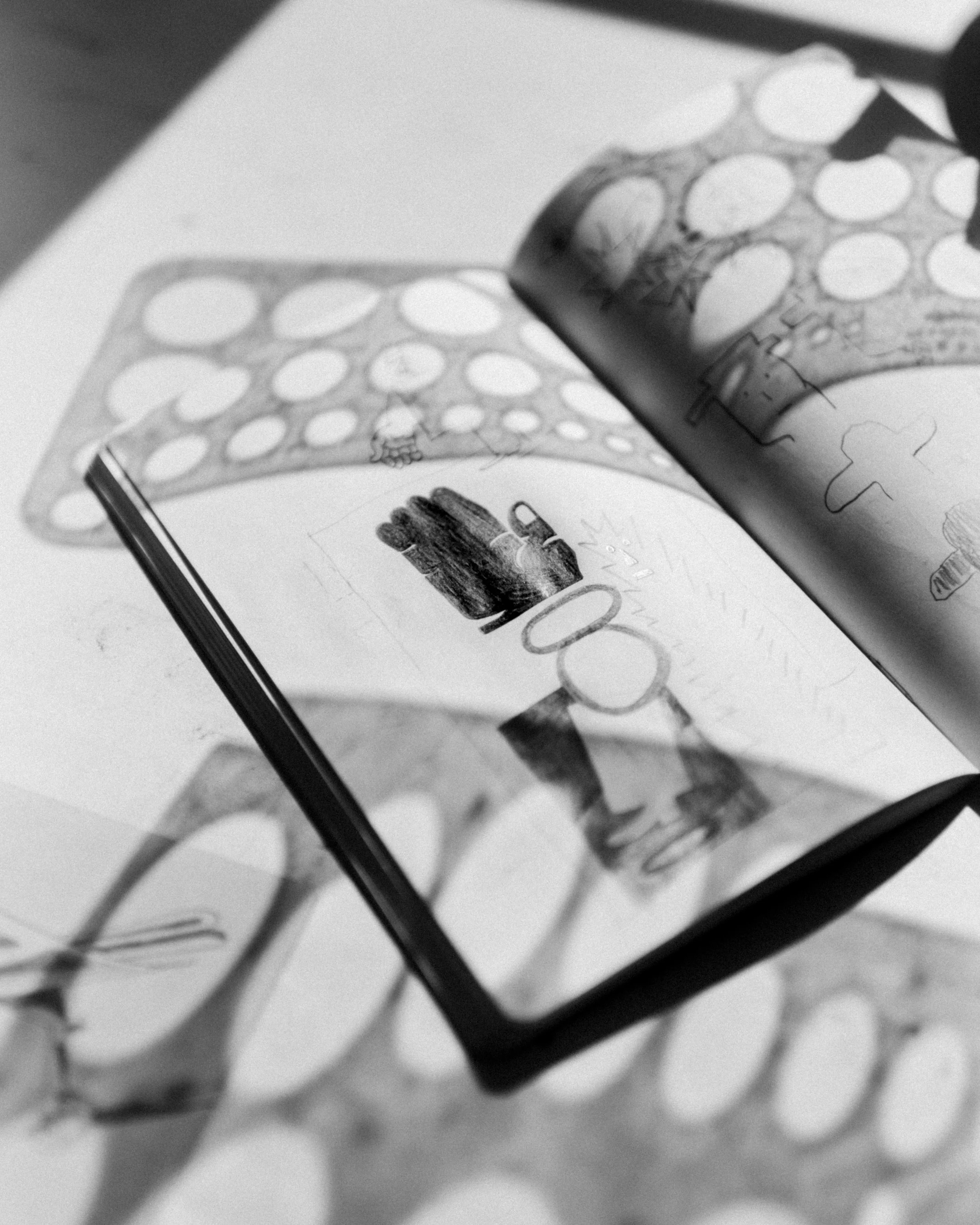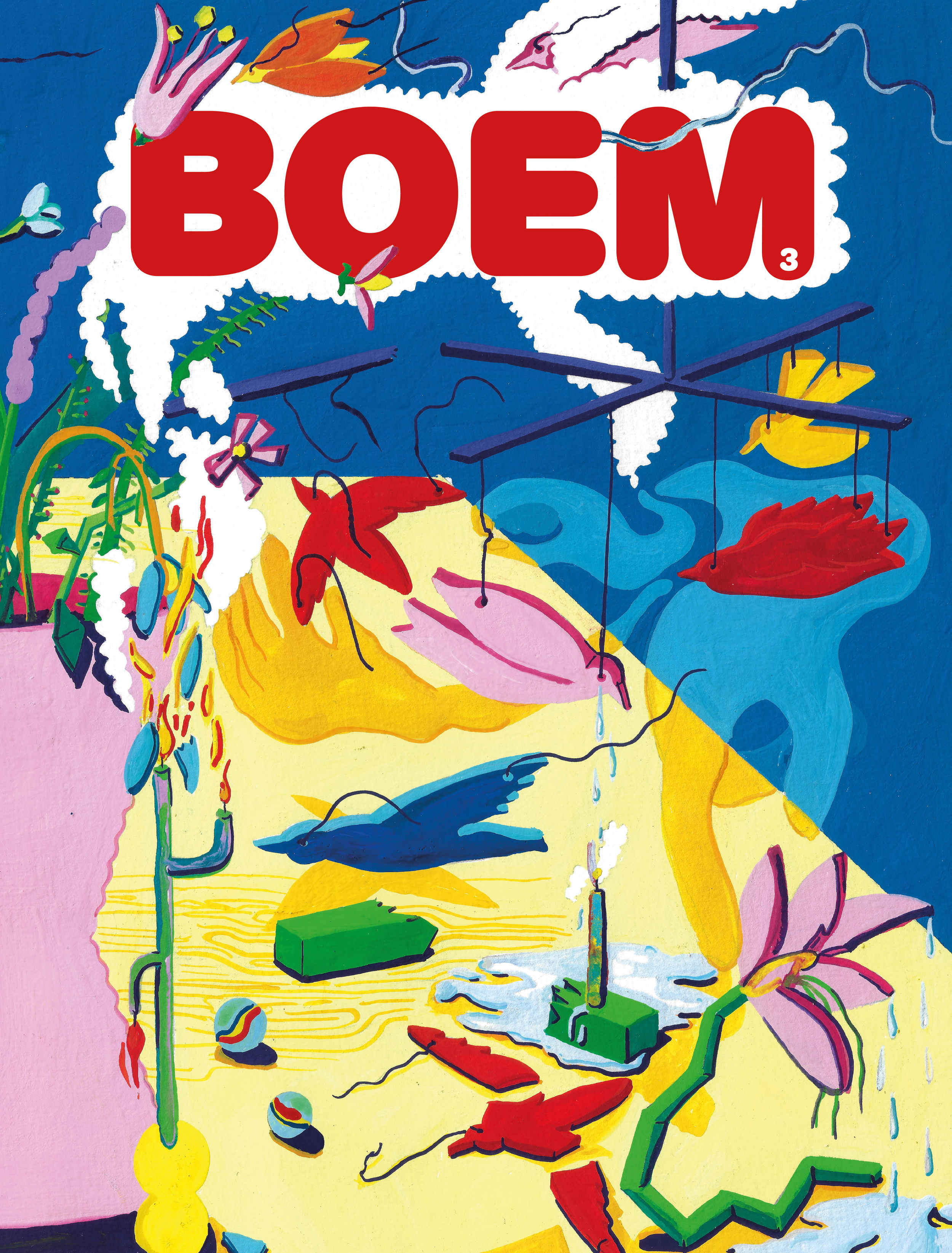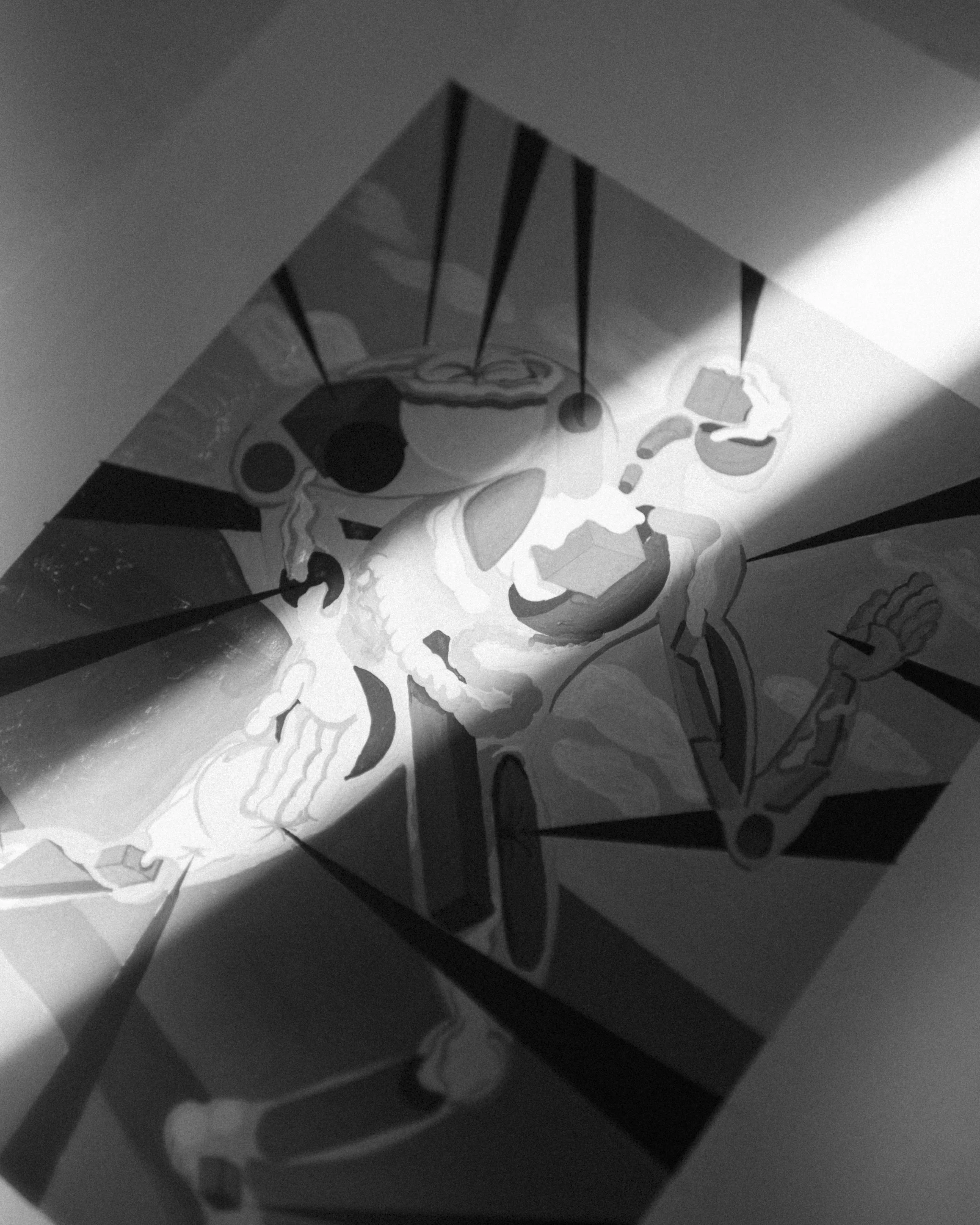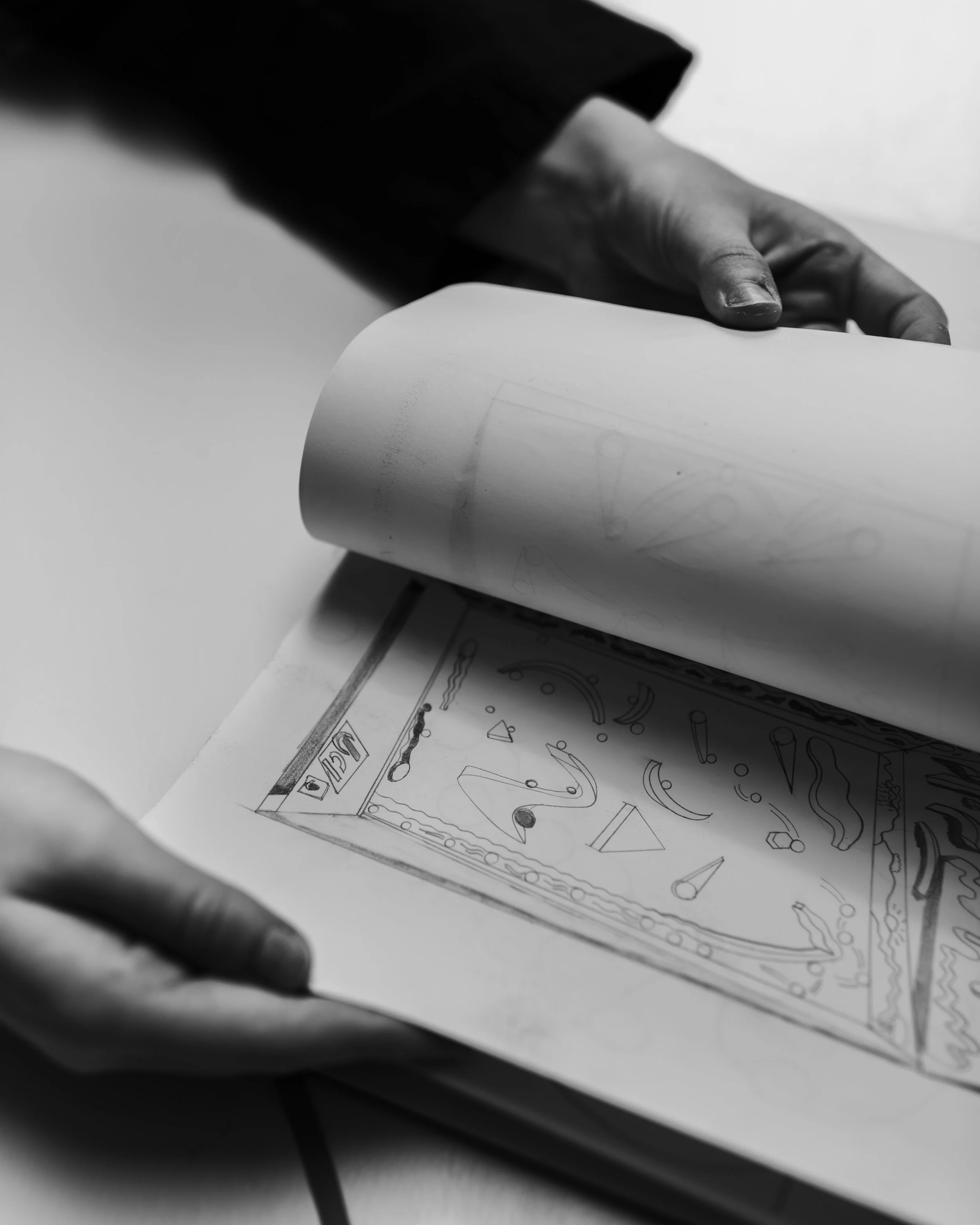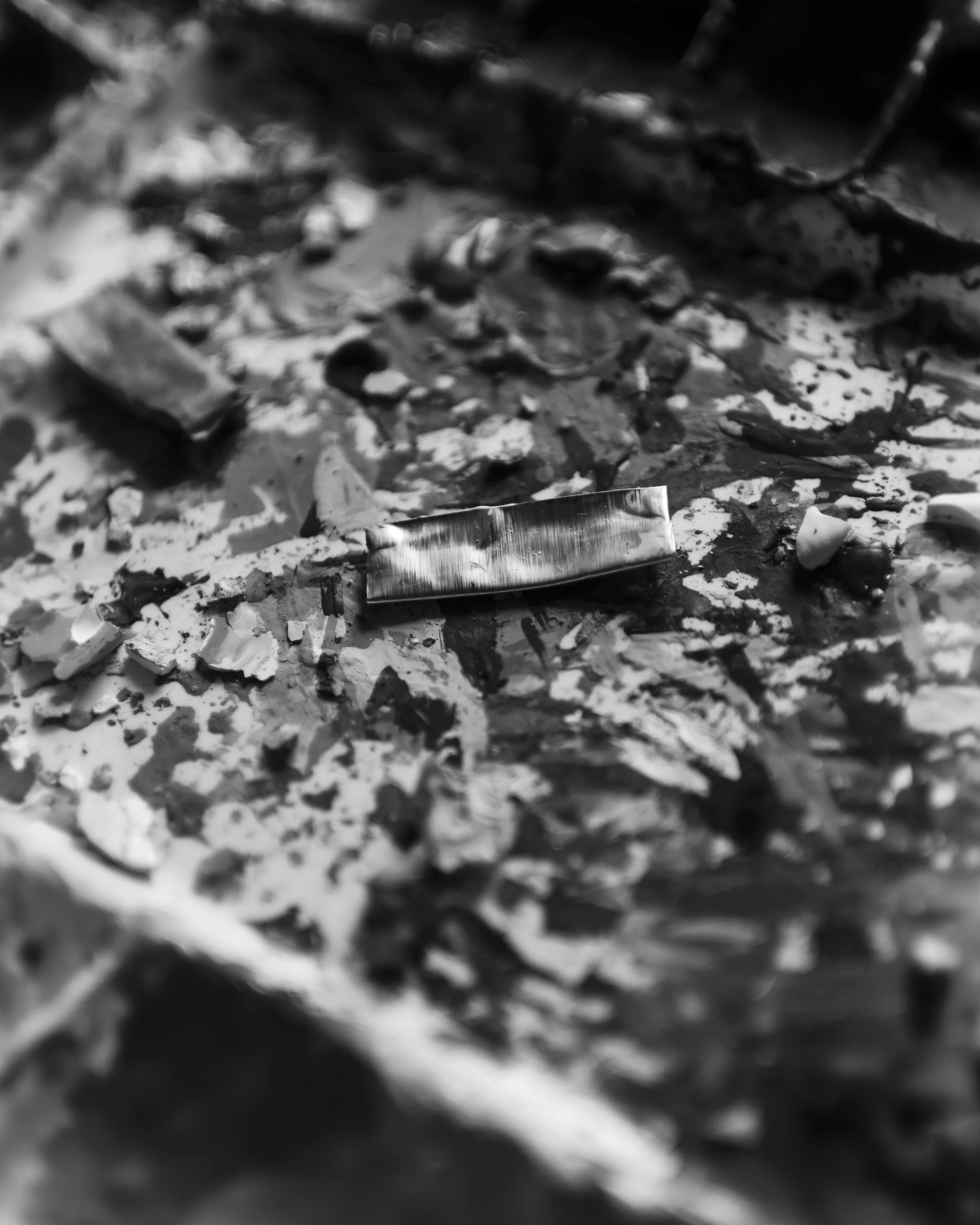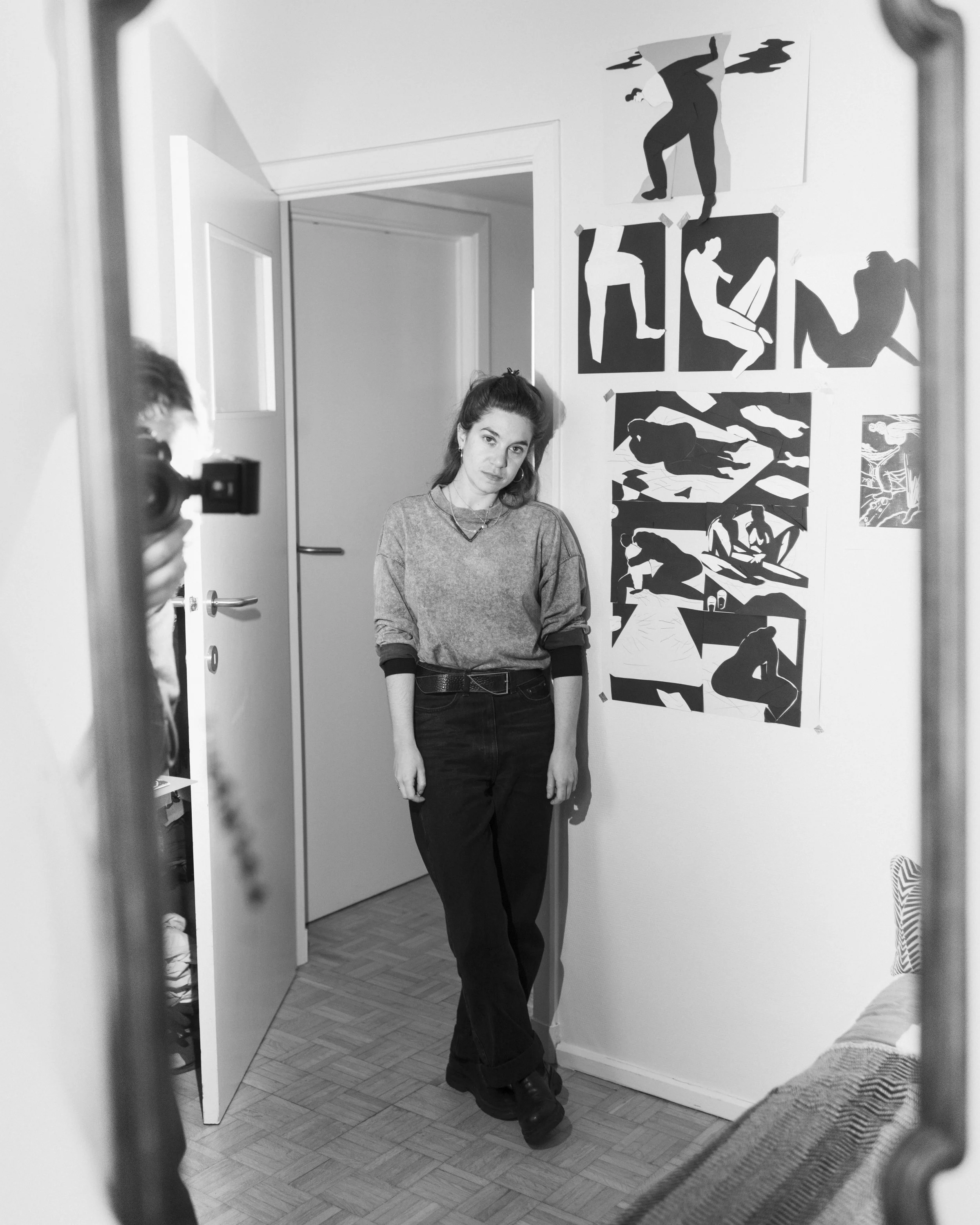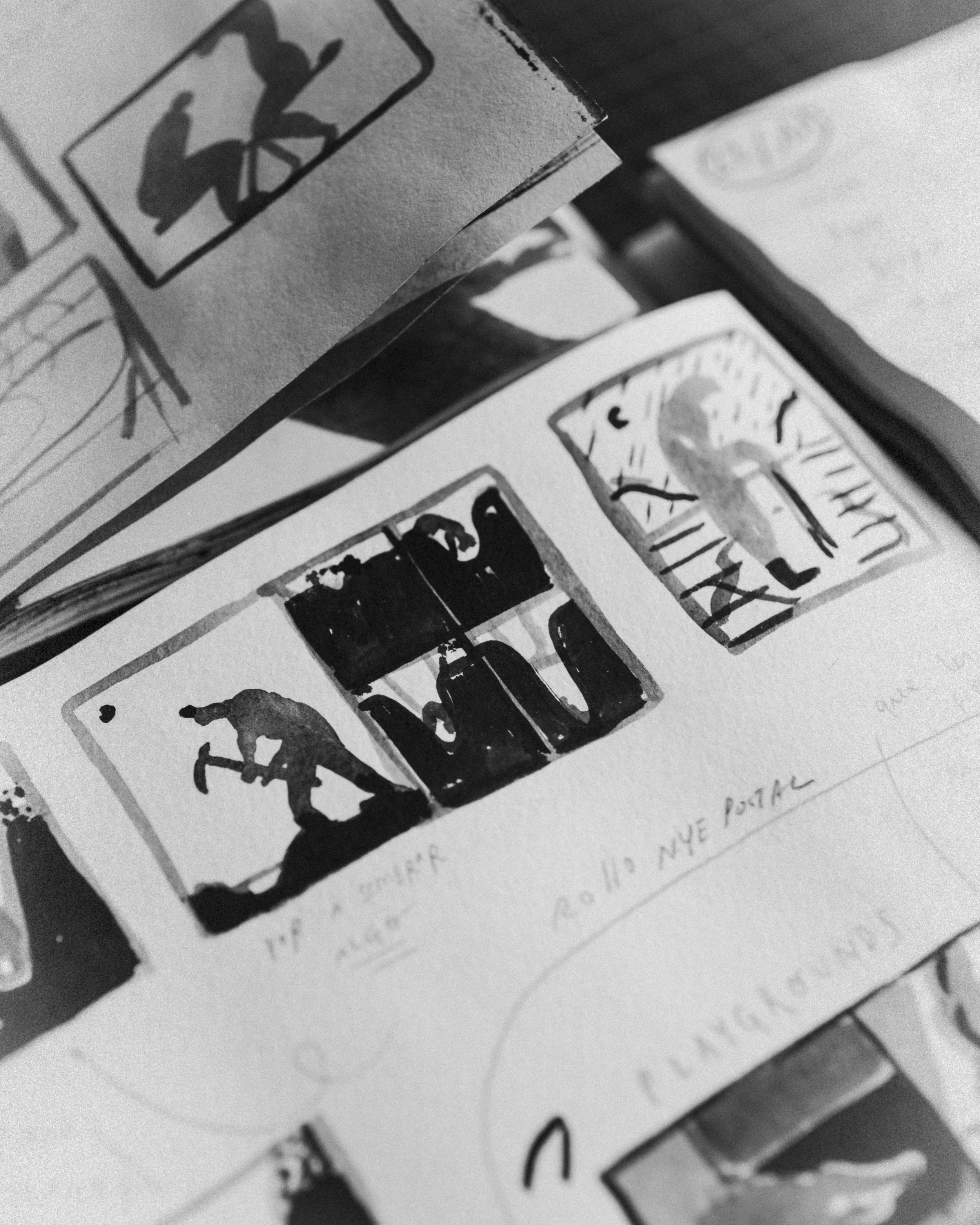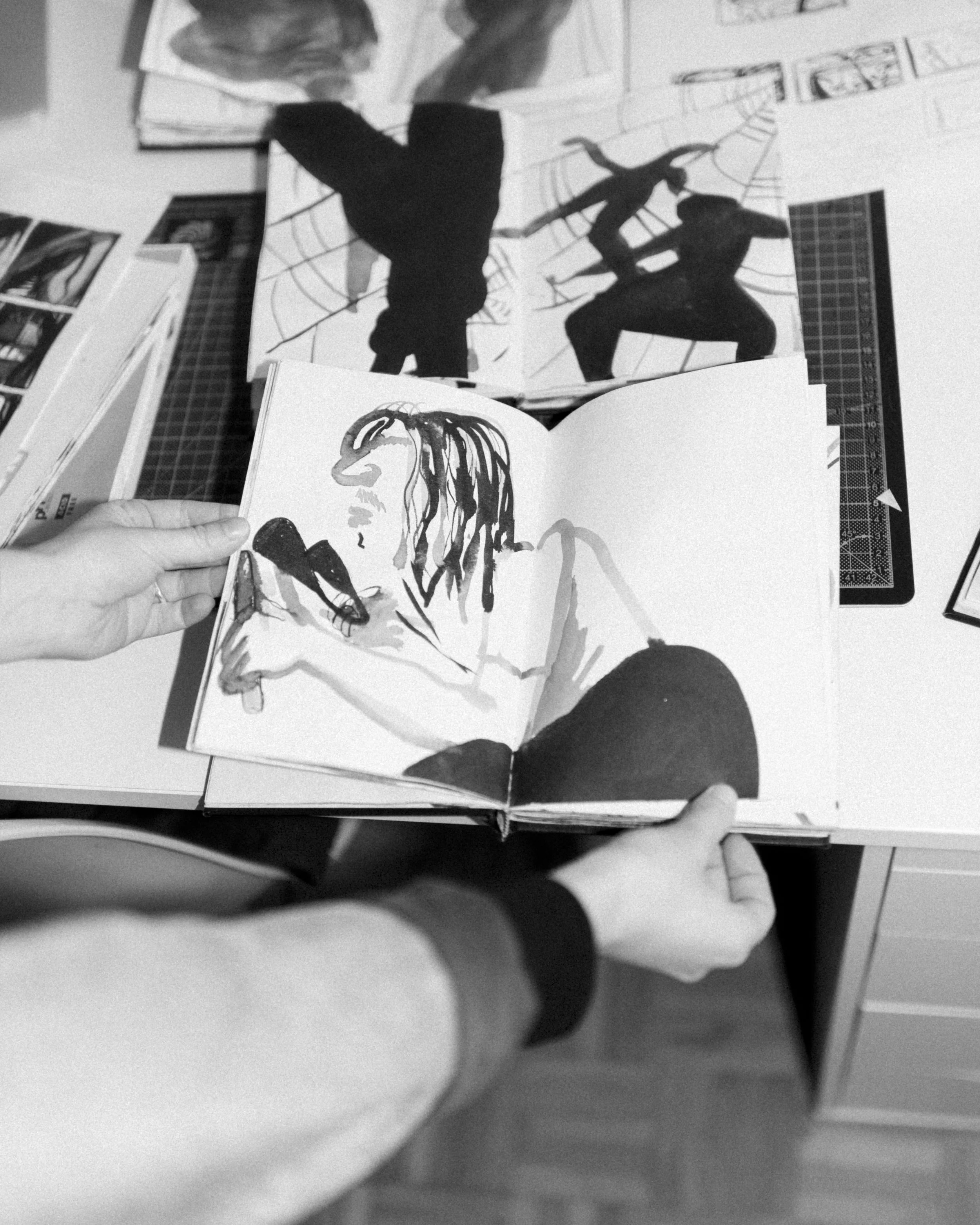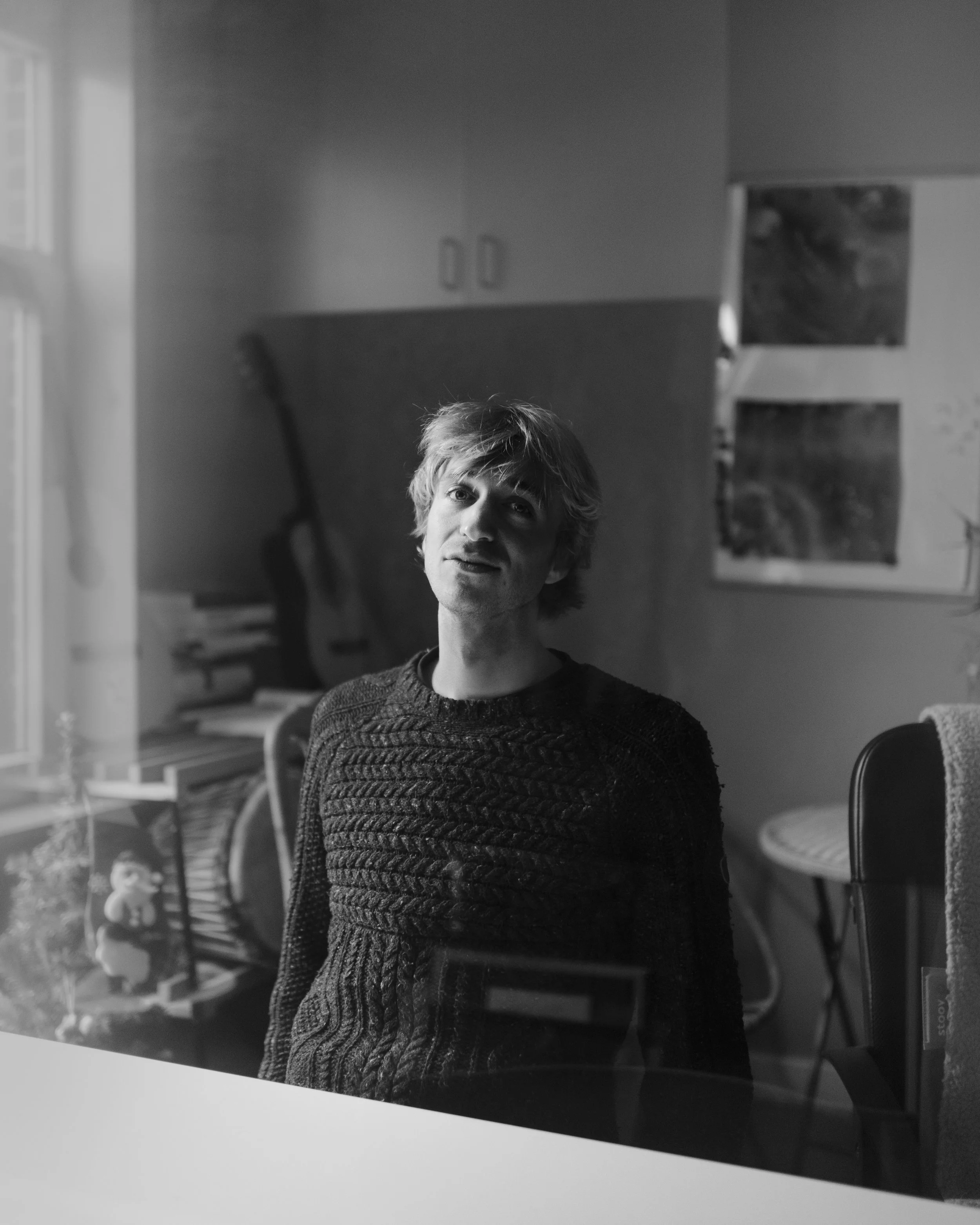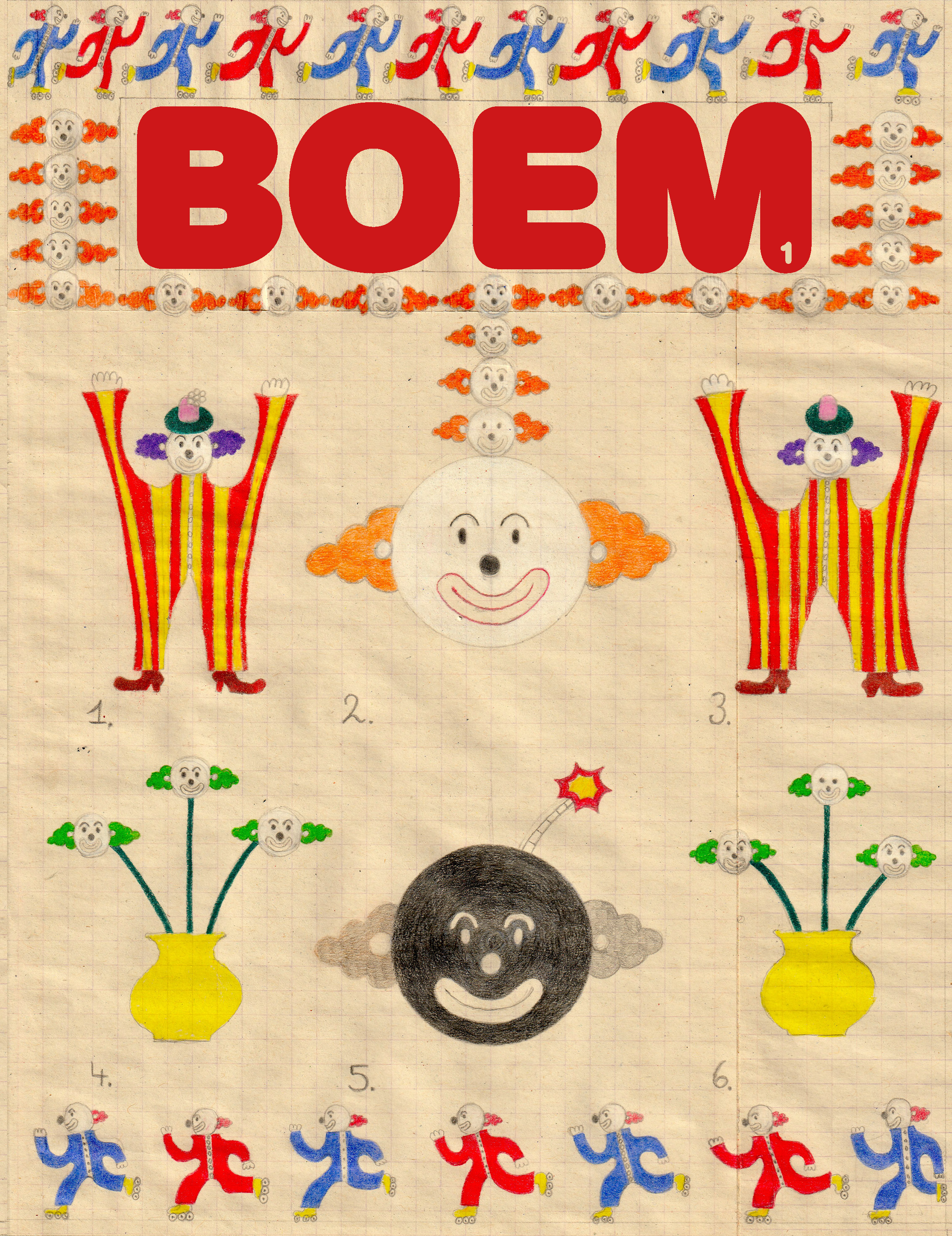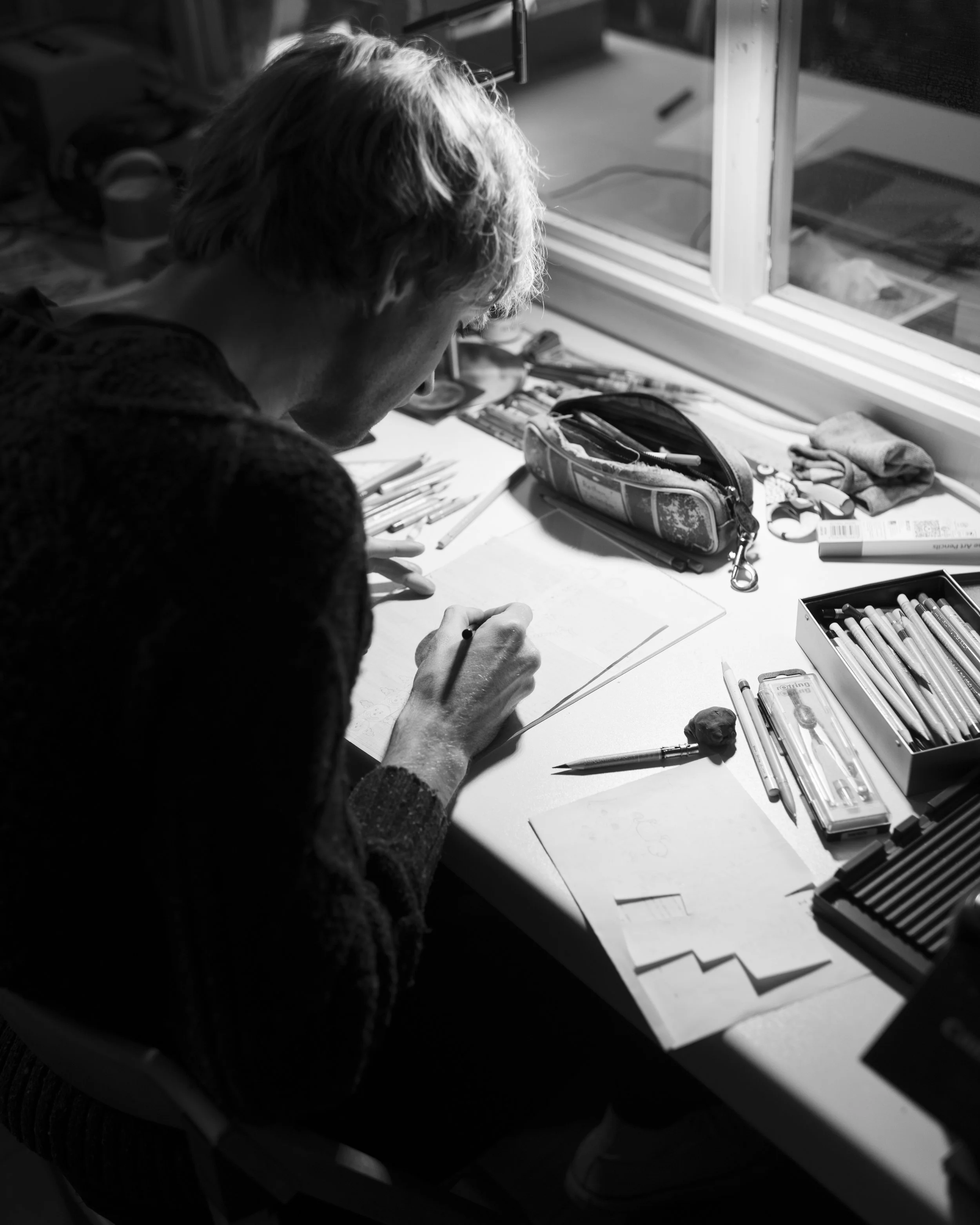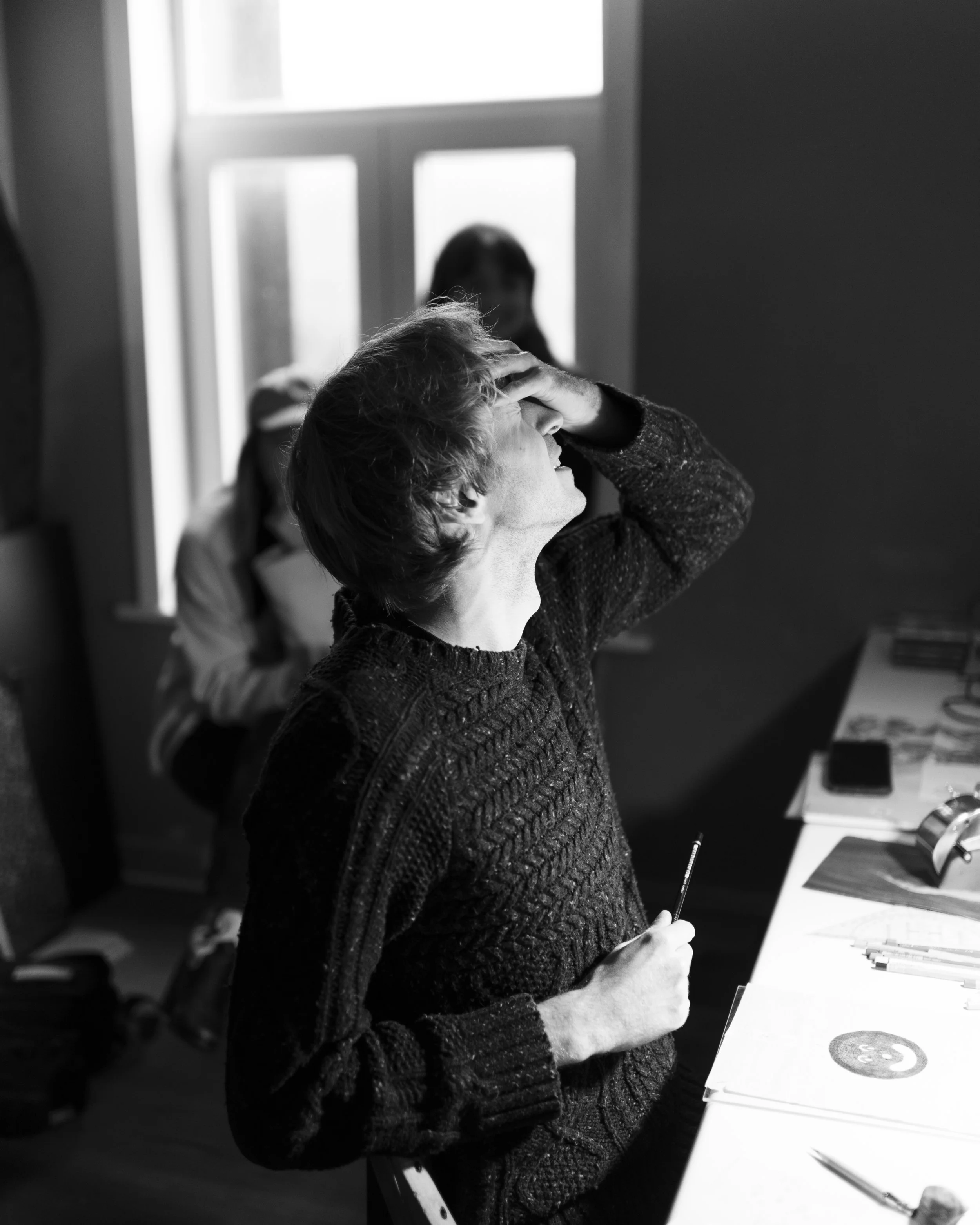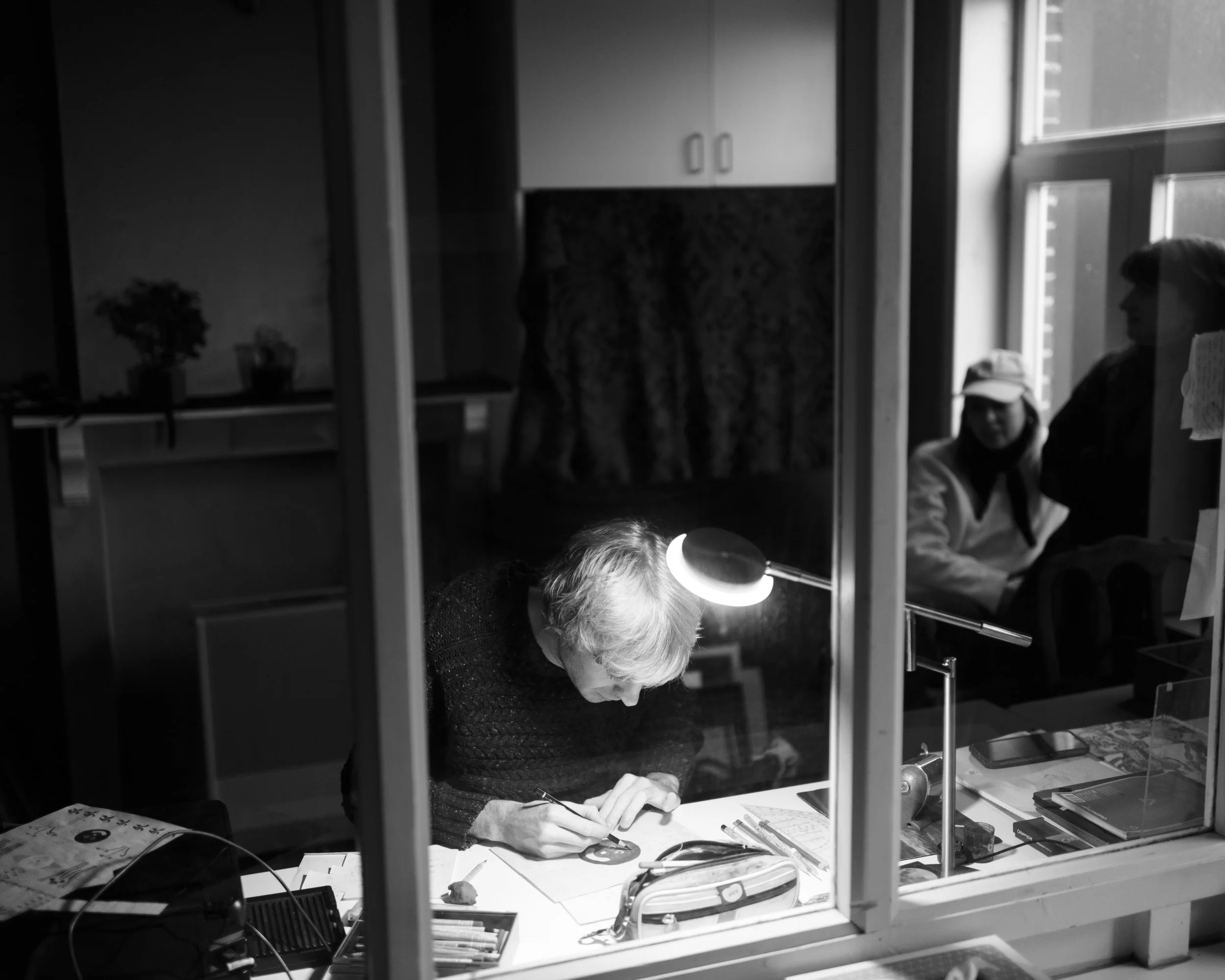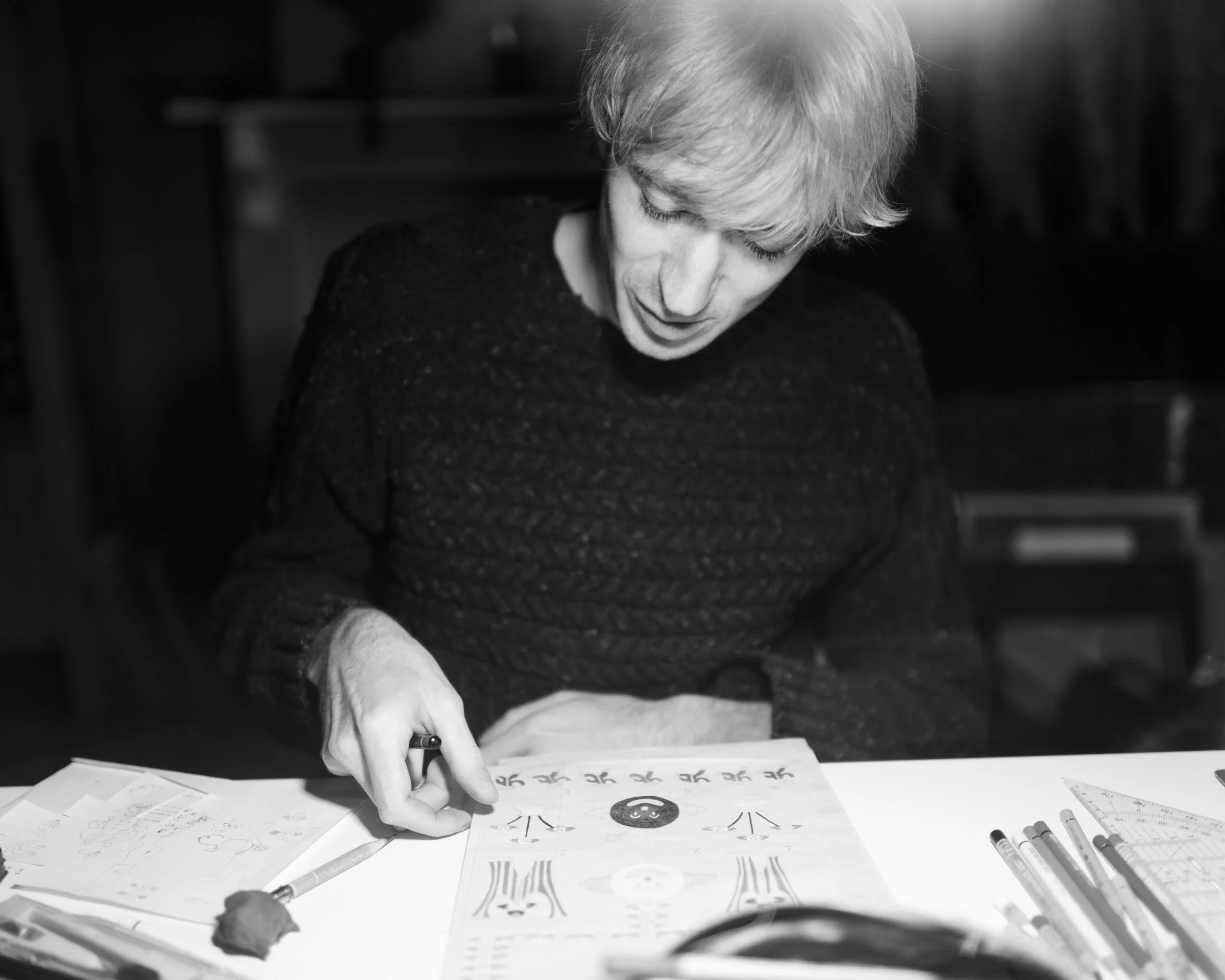Meet our cover artists!
For each edition, we visit the studio of the cover artist together with him for an in-depth interview. While Annelies and Sare speak with the artist, Basile captures the atmosphere, photographing the artist, their workspace, and the conversation as it unfolds.
This allows our audience to connect more closely with the artist and their practice, while also providing the artist with valuable material for their portfolio.
BOEM#4 : Disappearing
Thomas Janssens
How did you come up with the theme ‘Disappearing’?
The idea of choosing “disappearing” as a theme was initially inspired by the song “How to Disappear Completely” by Radiohead. In my own work, I often start from a sentence or short text that is both vague and ordinary, yet still leaves room to think further and evoke new associations. “
How to Disappear Completely” is a perfect example of such a sentence, and after coming across the song again recently, “disappearing” felt like the right choice.
What is your favorite material to work with right now?
Graphite has been my “weapon of choice” for many years. I’ve worked almost my entire drawing career in black and white, but I honestly don’t know exactly why I originally chose graphite. Ink, charcoal, or even black oil paint could have worked as well. Still, there’s something about the immediacy, precision, and versatility of graphite that no other material has been able to surpass for me.
What does the image you made for BOEM want to convey?
I’m not sure if the image really tells anything. I had many different ideas to work with, but a kind of “disorienting sinking” became the common thread. Perhaps it’s that feeling or experience that the image is trying to express.
What are five things you need around you for a good drawing night?
An audiobook (or silence, if I’m in the thinking phase), an unexpected snack brought by my lovely girlfriend, just enough water so I’m not thirsty but don’t have to keep running to the bathroom, my dog as the studio mascot in his little bed, and finally, a drawing that doesn’t resist me too much.
What is your drawing process and how do you start your work?
For me, creating a new piece always involves two fairly distinct phases: the thinking phase and the drawing phase. Sometimes I believe I should call myself a “thinker” rather than a “drawer,” since the thinking phase often takes the longest. Later in this phase, the “thinking” is accompanied by sketching, but I actually see sketching more as a form of thinking than actual drawing.
Once I have the image fully in mind and have made the toughest decisions, the drawing phase is really just about coloring in the idea.
Do you have a specific source of inspiration you often return to?
As I mentioned earlier, my concepts often originate from texts or sentences. The form these texts take can vary enormously: a passage from a novel, an overheard sentence on the train, a misheard song lyric, or simply a strange sentence that suddenly blows through my mind out of nowhere.
If your possibilities were endless, meaning there were no limits, what would be your wildest dreams?
To own a robotic lawnmower and a robotic vacuum cleaner.
How would you describe yourself in three words?
Existential, know-it-all, mustache.
If you could be friends with one of the figures from your cover, who would it be and why?
The figure in gray might seem like the most logical choice, but that one will soon disappear — not the most sustainable option for a friendship. So I’d choose the angular flower just above the figure’s right hand.
Do you have a message for BOEM readers?
“Disappearing is never sudden. It happens little by little, piece by piece, suspended between presence and absence — like riding into the sunset until you fade to a single dot, and then nothing.”
BOEM#3 : Still Life
Annelies Bollaers
How did you come up with the theme ‘Still Life’?
I chose the theme of still life because it’s a classic subject that almost everyone is familiar with. It’s a theme that everyone has an image of in their mind, yet it offers so many different possibilities.
People can even split the word and give it a different meaning. What if it’s not just a ‘still’ life? Maybe it contrasts with a noisy life? Is a still life always truly still, or is it full of meanings and symbolism that make it very expressive and powerful on a deeper level? I believe everyone can bring their own ideas to it.
Do you have a specific source of inspiration that you often return to?
My biggest inspiration is the outside world: the objects, people, and events I encounter. I often get inspired while walking through the city, forest, or a park. I might notice an interesting house with unique angles and details, or a lively bird perched in a tree. These ordinary things fascinate me.
What is your drawing process and how do you start your work?
I usually start with a loose sketch in my sketchbook, but I quickly move on to working on the final paper using graphite pencils and stencils. My drawings often have an almost architectural feel, with lines, shapes, and structures created using the stencils. I find it fascinating to create various shapes with these plastic stencils that don’t initially represent anything specific but gain new meaning later when mixed with figurative elements.
Sometimes the drawing can look quite chaotic and complex before I start painting. It’s only during the painting process that I get a clear vision of which colors to add. I never decide the colors in advance; they develop naturally as I work.
What does the artwork you made for BOEM want to express?
This piece is about freedom. The different elements and entities in the artwork try to gain their freedom. They break free from fixed patterns, habits, and cycles, moving toward a new future that might be better — or maybe not. Sometimes the grass really isn’t greener on the other side. Inside the inner pages, the elements stand still, organized differently because of the silence present there.
What is your favorite material to work with at the moment?
I prefer working with gouache. I discovered it a few years ago, and I’ve been hooked ever since. Gouache brings so much life and intensity to my work. It dries matte, giving it a graphic look, but up close you can see tiny imperfections and textures that add humanity and charm to the paint.
Mixing colors is a real passion for me — I love exploring different shades, from bright to dark. I never use pure black paint; instead, I mix my own dark colors like deep purple or dark blue. These create shadows and depth in a subtle way. Experimenting with color is very exciting for me.
How would you describe yourself in three words?
Perfectionist — sometimes to a fault, because I’m rarely fully satisfied with what I create. Solution-oriented — I believe there’s always a solution to every problem, which gives me peace of mind. And lastly, smiling — I’m someone who almost always wears a smile.
If there were no limits, what would your wildest dreams be?
If anything were possible, I’d move to a large house with a huge studio where I could work full-time on my paintings. A place where working on large pieces is easy, and where I’d also have the chance to travel. Traveling to discover and experience all the little corners, details, and everyday moments in different cities and villages.
What are five things you need around you for a good drawing evening?
My drawing table, my stencils, and my favorite brush that’s quite worn out but still makes a strong, good line. Also, a large cup of coffee — it’s become a habit to get my thinking process going. And finally, my cat Miso, who’s always nearby and likes to get involved with my paint and water containers.
If you could be friends with one of the figures from your cover, who would it be and why?
I’d rather not be friends with the little character in the frame with the single hair on his head — he looks a bit scary, and I don’t think it would be nice to bring him to life. But the little birds? I’d definitely like them to be real, so they can fly away and find their own way!
Do you have a message for BOEM readers?
Dive into the layers of symbolism and meaning within the images, and shape them into something that’s uniquely yours.
“Do you still think this is about a still life?”
BOEM#2 : Vertigo
Maria Farré
How did you come up with the Vertigo theme?
The first BOEM magazine theme, chosen by Arthur, really resonated with him and his work, and I thought it was a fitting start. However, I wanted to explore something more abstract and meaningful for the next issue. Circus, while specific, felt limiting, so I shifted to Vertigo. It’s a broad, relatable concept—particularly for artists who face uncertainty in their creative process.
Beyond art, Vertigo connects to various aspects of life, such as relationships and places. It opened up a larger universe for exploration and contrasted well with the previous theme. The unpredictability of how people would interpret it excites me—it adds a layer of anticipation, making me eager to see the variety of visual worlds come to life.
What is your drawing process like?
I start by writing down keywords and feelings in a notebook, which sparks small, abstract sketches. I use light grey ink at first, mapping out basic elements like people, spaces, or ideas. Then, I build connections, refining the design with darker ink and adding details.
This process evolves over time, requiring at least two days for me to step away and let my subconscious work. Research, both visual and theoretical, is key. I process information, then distract myself—whether through chores or walks—letting ideas settle before returning to refine the sketches. I prefer structure to spontaneity, and I find that balance tricky, especially in personal projects where I sometimes overthink.
What’s your favorite material to work with?
I love working with black ink, especially Chinese ink. It’s organic, portable, cheap, and offers room for mistakes – someting I find valuable in my process. The unpredictability of ink allows me to focus on strong contrasts and impactful compositions.
Lately, I’ve also experimented with paper cuts, which also offer minimal tools but unexpected results. While I usually work in black and white, I’m starting to introduce color, though I still prioritize composition before color choices. Ink’s messiness and drying time can be frustrating, but I embrace the imperfections – they add a raw, spontaneous quality to my work.
What does your artwork aim to express?
At the heart of my work is an exploration of human relationships and connections, expressed through the portrayal of figures. I want my drawing to create a space for communication, allowing the viewers to relate to the characters. The drawing then becomes this in-between space, a place of communication, which to me is one of the most important aspects of illustration.
Humor, often subtle of dark, plays a role in my work, even when tackling serious subjects. I also embrace mystery – my illustrations are suggestive, with clear concepts but open to interpretation. The balance between clarity and ambiguity, alongside humor, symbolism, and human connections, defines my work.
Do you have a source of inspiration?
I make a conscious effort not to take direct inspiration from other illustrators. Of course, I admire and check their work, but I try to maintain some distance. I find it too direct to create an illustration based on another illustration—I prefer inspiration from completely different mediums.
Instead, I draw from different mediums—conversations, music, atmospheres, or the way people move and interact. Books have also become an important source recently. Early in my process, I keep things broad and intuitive, focusing on a feeling or atmosphere rather than specific visual references. Once I refine the details, I may draw on other illustrators’ work to incorporate specific elements, but I always reinterpret them in my own way.
What are five things that need to be around you in your studio for a fun drawing night?
I snack on chocolate and, recently, wasabi balls – intense and sharp, like a wake-up call that matches the mood of my drawing sessions. Music is essential; it helps me avoid overthinking and allows me to let go. Along with black ink, water, and a good chair – sitting for hours demands comfort – these are the essentions for a productive night of drawing.
So yeah, wasabi balls, music, black ink, water… and a good chair. Can’t forget the chair. Hours of sitting can be brutal.
How would you describe yourself in three words?
I’d say optimistic, slow and moody. I tend to be optimistic, though sometimes impractically so. I’m slow in my work and actions, but maybe Flemish people are just too fast! In Spain, I feel slow too. Sometimes I feel a bit grumpy, though you wouldn’t notice. But I’d describe it as moody rather than negative. Maybe I’m also a bit reserved – shy is too strong, but sometimes I find it hard to express myself.
If you could be friends with one of the characters in your artwork, who could it be, and why?
The characters I connect with most have a strong presence – confident, expressive beyond just their face. Sometimes, I don’t even draw faces; posture and movement sat enough. The way a body carries itself can speak louder than words.
If there were no limits and anything was possible, what would be your wildest dream?
Honestly, making a living through illustration. That’s my goal right now – working toward it every day.
Do you have a message for the readers?
Sit down if you are feeling dizzy.
BOEM#1 : Circus
Arthur Devisscher
How did you come up with the theme ‘Circus’?
I was working on drawings for an orchestra at the time, and I noticed that I kept drawing more and more circus-related things. So, moving to a real circus theme was actually a very small step.
Do you have a specific source of inspiration you often turn to?
I don’t think so. Usually, I just see something in my mind. Probably things from my surroundings, often unconsciously. I don’t actively look for sources of inspiration, like artists or art books. For example, here (points to a small square drawing of a gray mouse), I once dreamt about a mouse on wheels. And then I *had* to draw it. Maybe I’ll use it in a work someday. I believe ideas always come from somewhere, but not always consciously.
What’s your favorite material to work with at the moment?
I’d say colored pencils, but that doesn’t feel entirely right. I got this (points to an ink brush). It’s a brush with ink in it. I don’t necessarily love the results; I haven’t made anything amazing with it yet. But it’s fun to use. You have control over how the brush releases the ink, and you can make thick and fine lines with it.
My favorite material doesn’t depend on the end result, but rather on the joy of making. I often use colored pencils because they give a nice result, but are they my favorite? I don’t know. I also enjoy paint. I recently did a mural and tried different painting techniques. My favorite material really changes over time.
What message do you want to convey with the artwork you created for BOEM?
I thought: it’s called BOEM, and it’s the very first edition. So, I found it funny that the clown on the cover is a bomb. And then I count down: 1, 2, 3, 4... as the start of the BOEM project and the bomb going off. Beyond that, I mostly want it to be funny because a circus is funny. I want people to feel cheerful when they see my cover. But honestly, it’s also a bit grim—the idea of that bomb...
What’s your drawing process like, and how do you start your work?
For the cover, I started differently than usual. Normally, I sketch everything in pencil first and then color it in. But I was getting a bit tired of that. It would always end up completely filled, with tons of detail. Then I saw this paper (shows yellowish paper, resembling an old notebook page left in the sun for years). Grid paper. If I colored it in completely, you wouldn’t see the grid anymore.
So, I came up with a way to keep the grid visible in my drawing. That made it a bit more graphic. I’m actually using the grid now. It turned into an experiment. I even had to tape the sheets together to get the right size for the zine.
The first thing I drew for the circus theme was an elephant. Then I started drawing more elephants and added flowers. But then it started looking too much like Indian art, not really "circusy" enough. So, I added a dolphin with a ball. On the back, I put an octopus on roller skates. That was my first concept. But then suddenly, I thought: I want to draw a clown. And that completely changed the image. It became graphic, with grids... and clowns.
If you could be friends with one figure from your cover, who would it be and why?
Let’s see... There are a lot of characters, huh. Aha! (points to a clown-like flower) This flower, which is also a clown. There’s one without eyebrows that I find a bit creepy. It reminds me of the clown from *It*. But it would still be fun to be friends with it because it can’t move in my drawing, so it can’t be annoying!
What are five things you need around you for a good drawing session?
Alcohol! Haha, no, just kidding. That was the first thing that came to mind, but it almost never happens. A CD player with CDs, so music, but not always. A good sharpener. A nice lamp—very important. Pencils, of course, but that goes without saying.
Outside of drawing materials? An electric heater! It gets really cold here in winter. Maybe a knife? No, no, just kidding. Ah! A scanner! I use that more and more. It’s important to scan right away when I’m happy with a drawing. That way, I can always print it later if something happens to the original. And a chair! Right now, I don’t have a good desk chair. This one’s too hard... although that might be good for my posture. My final top five: lamp, CD player, scanner, chair, and sharpener.
How would you describe yourself in three words?
Me? Hmm... I don’t know. Don’t you know? (asks the interviewers) It doesn’t have to be about drawing? Okay... Friendly? Is there anything else besides friendly? Positive, I think. Not 100 percent, of course; I don’t believe anyone can always be positive. And driven! Those are very nice descriptions... Maybe I should throw in a bad trait, like manipulative. Just kidding!
If you had infinite possibilities, what would be your wildest dream?
A house in the south of France, in the mountains... That’s not *too* wild, right? But then with everything included: shops, friends, everything I need. A place where I only have to draw. Well, I’d still want to cook and do laundry, but everything else someone else could do. Cleaning, for instance—no, thanks! I’d find someone who likes cleaning to maintain my house there. I used to travel to the south of France a lot; it always seemed so warm there, though maybe that’s not reality.
Maybe I should reconsider the location—somewhere where it’s always really warm. The more I think about it, the less unrealistic it seems. But whether I’ll ever actually do it? No idea.
Do you have a message for BOEM readers?
Okay, I love every BOEM reader very much! No, wait, I have a better idea. BOEM is about experimenting, right? So here it is:
“Boem boem boem boem, I want you in my room!”

